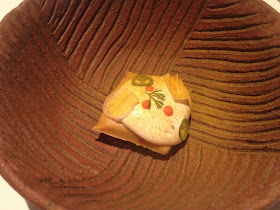This year Carla and I had the pleasure of trying another of Mexico City's top restaurants - Pujol, headed up by Chef Enrique Olvera. Along with Biko, Pujol boasts a position on the San Pellegrino list of the top 50 restaurants in the world (#36 in 2012). Whereas Biko drew upon its Basque roots, Pujol is undeniably all about Mexico - but don't be fooled, the level of innovation in the presentation of the classics is extremely high while maintaining a very traditional feel. One of the things that struck me the most was the hoja santa tortilla - upon presentation, you can only see the masa of the tortilla, but the underside has the leaf of the hoja santa fused to it. As we usually do, Carla and I went for the tasting menu - here's how it went.
The amuse bouche: roasted baby corn with corn husk mayonnaise, a miniature aguachile, and a tea of corn and ancho chilis.
Souffle with celery, lemon and coriander cream (inside) and caviar.
Beef tartare tostada with alfalfa and serrano chili.
Fish ceviche taco with hoja santa tortilla and beans.
The hoja santa side of the tortilla.
Fried frog leg with chayote squash, cauliflower puree and poblano chili sauce.
Squash blossom tamal with epazote xikil pak sauce and queso fresco.
Suckling lamb taco with avocado and green pea puree, tomato and hoja santa sauce.
Yucatean pork confit with raisin and cumin mole, almond, tamarind and clauliflower.
Roasted baby banana, zested macadamia nut, chamomile, cacao and cream.
Thyme biscuit, lemon gelatin, pulque sorbet, cookie soup and white chocolate.
Guava sorbet, worm salt, and mezcal flambe.
Chocolate mousse with citrus cream.
We were also met at the door on our way out with some stellar mignardaise.
And there you have it. As expected at this level, service was excellent, but the restaurant maintained a very relaxed and casual atmosphere. They are very accommodating if you need English translation, just be aware that some local culinary terms just don't translate well. Book in advance as most nights do tend to sell out. Find Pujol at Francisco Petrarca 254 in Polanco, Mexico city.










































